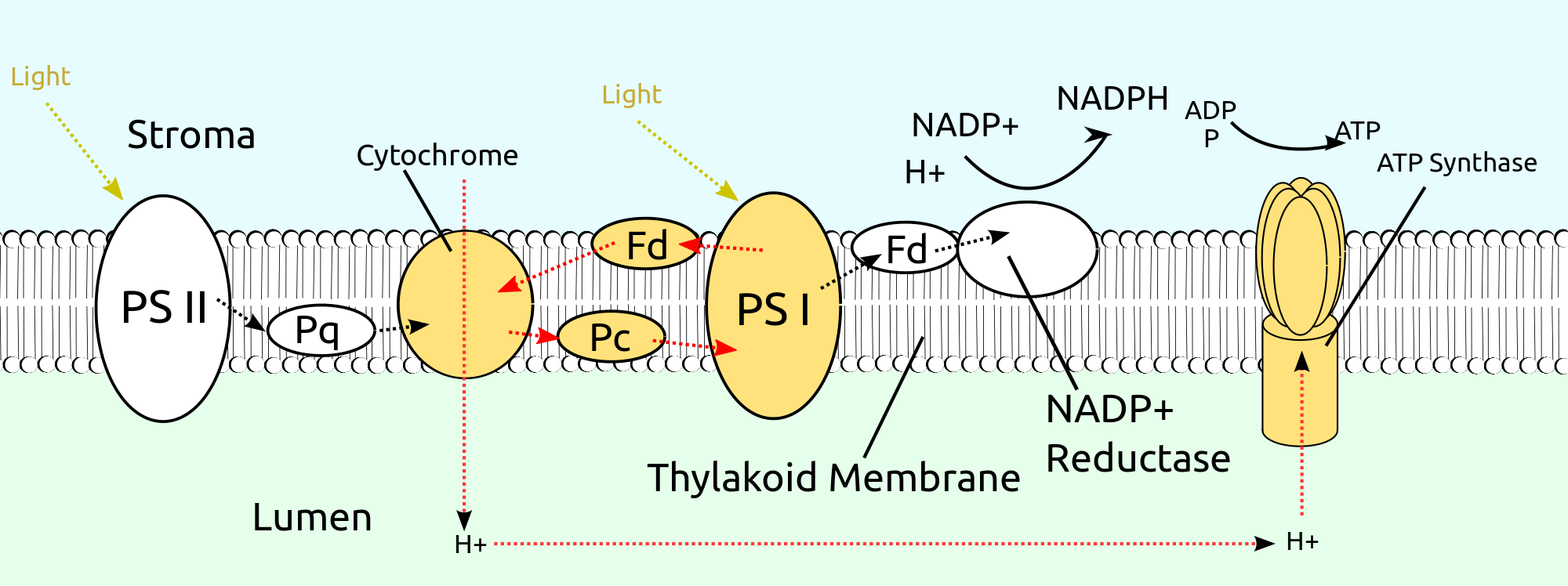Cyclic photophosphorylation and non Cyclic photophosphorylation
Cyclic photophosphorylation and non Cyclic photophosphorylation
Electron transport system
The light driven reactions of photosynthesis are referred to as electron transport chain.
When PS II absorbs photons of light, it is excited and the electrons are transported through electron transport chain of plastoquinone, cytochrome b6, cytochrome f and plastocyanin.
The electrons released from PS II phosphorylate ADP to ATP.
This process of ATP formation from ADP in the presence of light in chloroplast is called photophosphorylation.
Now, the PS II is in oxidised state.
It creates a potential to split water molecules to protons, electrons and oxygen.
This light dependent splitting of water molecules is called photolysis of water.
Manganese, calcium and chloride ions play prominent roles in the photolysis of water.
The electrons thus released are used in the reduction of PS II.
Similar to PS II, PS I is excited by absorbing photons of light and gets oxidised.
This oxidised state of the PS I draws electrons from PS II and gets reduced.
The electrons released to PS I are transported through electron transport chain of ferredoxin reducing substrate, ferredoxin and ferredoxin NADP reductase to reduce NADP+ to NADPH2.
Cyclic and noncyclic photophosphorylation
In chloroplasts, phosphorylation occurs in two ways – non cyclic photophosphorylation and cyclic photophosphorylation.
Non cyclic photophosphorylation
When the molecules in the PS I are excited the electrons are released. So, an electron deficiency or a hole is made in the PS I.
This electron is now transferred to ferredoxin to reduce NADP+.
When the molecules in the PS II get excited, electrons are released.
They are transferred to fill the hole in PS I through plastoquinone, cytochrome b6, cytochrome f and plastocyanin.
When the electron is transported between plastoquinone and cytochrome f, ADP is phosphorylated to ATP.
The ‘hole’ in the PS I has been filled by the electron from PS II.
Then the electrons are transferred from PS I to NADP+ for reduction.
Therefore, this electron transport is called noncyclic electron transport and the accompanying phosphorylation as noncyclic photophosphorylation.
The noncyclic electron transport takes place in the form of ‘Z’. Hence, it is also called Z-scheme.

Cyclic photophosphorylation
Under the conditions of
(i) PS I only remains active
(ii) photolysis of water does not take place
(iii) requirement of ATP is more and
(iv) nonavailability of NADP+ the cyclic photophosphorylation takes place.
When the molecule in the PS I is excited, the electrons are released.
The electrons are captured by ferredoxin through ferredoxin reducing substrate (FRS).
Due to non-availability of NADP+, electrons from ferredoxin fall back to the molecules of PS I through the electron carriers ¬ cytochrome b6, cytochrome f and plastocyanin.
These electron carriers facilitate the down hill transport of electrons from FRS to PS I.
During this transport of electrons, two phosphorylations take place – one between ferredoxin and cytochrome b6 and the other between cytochrome b6 and cytochrome f.
Thus, two ATP molecules are produced in this cycle.

For more information about photophosphorylation click here
Other links
Plant tissue culture – origin and techniques
Plant physiology – photosynthesis and its significance
Site of photosynthesis and Mechanism of photosynthesis
Factors affecting photosynthesis
Test tube and funnel experiment, Ganong’s light screen experiment
Mode of nutrition – Autotrophic, Heterotrophic
Mechanism of Respiration – Glycolysis
Mechanism of Respiration – Oxidative decarboxylation , Krebs cycle
Mechanism of Respiration – Electron Transport Chain, Energy Yield
Ganong’s respiroscope, Pentose phosphate pathway
Plant growth and Measurement of plant growth
Phytohormones Cytokinin, Ethylene, Abscisic Acid, Growth Inhibitors – Physiological Effects
Photoperiodism and vernalization, Phytochromes and flowering
